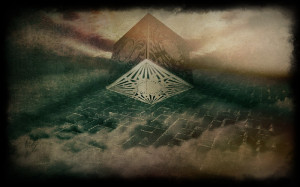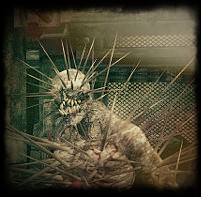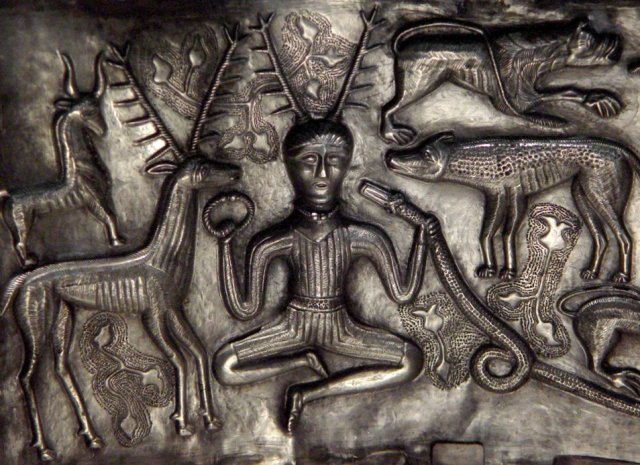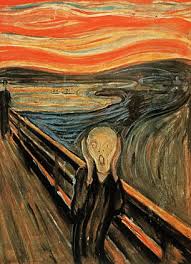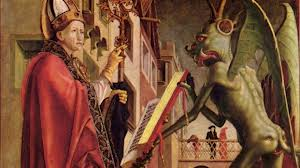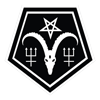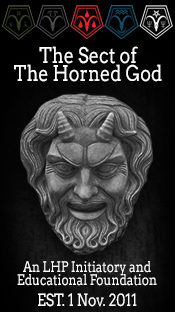The Cloven Hoof July/August XII AS (1977)
Contributed by Jake Block
This is a piece from The Cloven Hoof July/August XII AS (1977) that Satanists today might benefit from. In it, Anton LaVey wrote:
” When I brought Satanism out of the closet, I had to put on a show to let the world know we existed in fact and not just in theologian’s rulebooks. Once established, many roads of influence and control would present themselves. And they have. I won’t see Satanists cavorting for the public like monkeys anymore. Professional performers who are …being well paid for Satanic show-and-tell can and will continue to take care of that area.
You are the real thing. The public has a fine fun-fear image of Satanists that can be conveniently switched off on their TV sets or when they leave the theater or close the book. Your purpose (and privilege) us to be able to reap the rewards of all that flack, not perform little theater in between times. Let them know you’re a C/S member. Explain philosophy if you feel like it and it invigorates you. Otherwise, let them think the worst or best — whatever they need. Above all, don’t provide entertainment unless the stakes are worth it.
The Satanic Bible is available (or should be) to answer doctrinal questions others may ask. Instead of being a colorful evangelist, eager to Spread The Word, you should be an enigmatic individual whom others have good reason to ponder and respect.
Nothing infuriates — or scares — others so much as unpredictability. When the pro/pop/show-and-tell Satanists condition the public to expect stereotypical appearance and lifestyle from Satanists, it is your cue to confound and confuse them “until the stars be numbered.” Make them wonder what being a Satanist does for you and what strange and potent force you are linked with. Just others’ knowledge that you are a Satanist is sufficient to accomplish that. The more of a show you give them, the less they have to speculate upon. And the more predictable (= safe) and entertaining you become.
If you want to be a spooky Gothic type Satanist for the world to see, be prepared to lose more than a little of your potential power. This doesn’t mean you can’t decorate your home in a bizarre manner. It should only caution you to screen your guests carefully if you have devil statues in every corner. Get the point? Better yet, if you don’t send them away with anything to upset their balance — yet they know you’re with the C/S — they will REALLY be unhinged (or intrigued). You made your point without entertaining them as a “Satanist” should.”
1977 or 2014, it’s still good advice and spot-on analysis that I’ve found has served me well.
The Chest-Beaters

by Thomas LeRoy
“I walked the path to the left!” said a man, beating his chest, in the village square. “I know all there is to know of it’s ups and downs, it’s hills and valleys, its crags and meadows.”
Another man stood and he, too, beat his chest proclaiming, “I have faced the demons on the path! I have conquered them and have made them my slaves!”
And still another. “Lo, I have trekked where no man has trekked before! I have seen sights that would melt the eyes of most men!”
And another.”I have tasted the spices of Hell, and have drunk the mead of Hades! Cerberus, I have made my pet, and Kali my lover! Satan and Shiva have bowed down before me for I am divine! I am my own God!”
“Excuse me,” said the Individual, raising his hand.
But the others kept pounding their chests, trying to out-do one another in volume and bombast.
“Excuse me!”
The square went quiet for a moment.
“I have a question,” said the Individual. “If you all had been on the path, and have found your divinity, then why are you still here in the village?”
The Promise
A work of fiction by Thomas LeRoy
The boy gazed out the arched window and listened as the call to prayer echoed off the walls and minarets in the haze of a fiery sunset. He hated the Muslims, but he found that haunting song strangely beautiful.
“Why aren’t you going to prayer, Yusef?” said the boy as he lay on his stomach, a servant dressing the lash marks on his back.
Yusef the man-servant shrugged. “I think Allah will forgive me this just once. Besides, your wounds need care, young master.”
The boy flinched as Yusef gently applied a healing ointment.
“My brother may not mind getting buggered by the sultan, but I will never willingly offer myself to his urges,” said the boy.
Yusef sighed. “And you will continue to be lashed.” The servant set the ointment jar on a table. “There, I am done. I think you will live.”
The boy pushed himself up into a sitting position as Yusef handed him a fresh tunic. “I am a prince,” the boy said as he dressed. “A prince does not succumb to the whims of a twisted old man.”
“But your brother has,” said Yusef. “And he is a prince.”
“Radu is no prince. More like a princess.”
Yusef chuckled.
The boy stared at him.
“Forgive me, young master,” said the servant as he placed his hand over his heart and gave a slight bow. “Oh, I almost forgot. I bought something for you today at the bazaar.” Yusef went to a leather bag hanging from a peg on the wall, reached in, and pulled out an item. “Here, I thought you might find it entertaining. It’s a puzzle-box.”
The boy took the box and studied it. It was metallic, with strange etchings upon it’s surface. This was an early example of a puzzle-box that would be perfected three centuries later by Philip Lemarchand, a French maker of mechanical birds. LeMarchand would construct more than 270 of his puzzle-boxes before vanishing off the face of the earth.
“How does it work?” said the boy.
Yusef shrugged. “I know not.”
The boy set the puzzle-box on his cot. “I will rest now,” he said. “Find your leave.”
Yusef bowed again. “Very good, young master.”
The boy was restless as he lay on his stomach, pillows propped up under his chin. He knew someday he would leave this heathen hell-hole and return home to his father. But until then, he had to survive.
He sat up, and lit an oil-lamp hanging beside the bed. He looked about for the puzzle-box among the blankets. Finding it, he again examined its craftsmanship. It was a thing of beauty. He scratched his head, then went to work on trying to figure out its “puzzle”.
The concept of time became lost to the boy as he spent hours obsessing over the box. Then, out of pure luck he heard a “click” and the top third of the puzzle-box began to automatically rotate counter-clockwise. And as it did, a tinkling of bells could be heard. When it stopped, the bottom third began to rotate clockwise. And what was originally light bells, now began to sound like the church bells of the boy’s homeland. But the sound did not come from the box, but from somewhere else, far away, yet very near.
“Who could have made such a thing?” whispered the boy.
Now, if he had gone to the bazaar and inquired as to the origins of the strange little device, he would have learned that it had been created by a heterodox sect of Muslims back in the 9th century. This small band of heretics revered the book called the Al Azif, written in the 8th century by the “Mad Arab” Abdul Alhazred. During that age the Azif gained considerable, though surreptitious, circulation among the practitioners of the arcane arts. Then, in 950, it was translated into Greek by Theodorus Philetas and given the title The Necronomicon.
He set the puzzle-box on the table and watched. The top of the box slowly opened, and the walls of his chamber began to grow faint, dissolving, and the flame from the oil lamp flared. But the boy paid little heed to these things. His eyes were fixed on the box.
The sound of bells tolled one last time, the oil lamp went out, and the chamber was cloaked in a blackness darker than that he could ever imagine. The darkness was stifling and he could feel a pressure, as though he were at the bottom of a deep lake.
There was a strange scent in the air, like sweet spices and a soft azure glow began to compete with the blackness. Then he heard heavy breathing.
He turned, and where the wall beside his bed should have been, was now an open void, and standing before him was a creature the likes of which his young eyes had never beheld. The boy jumped to his feet.
“I have come,” said the creature. Its thick black lips smiled.
The being before him was a man, or may have been at one time. How it could be speaking, or even breathing, was beyond the boy’s imagination. It had iron stakes, many, shoved through its leather-clad body, some going from the right hip up through the left shoulder, others through the rib-cage, the back, shoulders and even out the top of its bald, blue/white head.
“Do you know what you have done, boy?” said the being in a soft voice, speaking a language that was neither Turkish, nor his native Romanian, yet the boy somehow understood it. “You have called upon me, and I have come. Now we shall leave.”
“Where?” muttered the boy.
“Where? Where?” The creature laughed. “We go to a land of green fields, and open meadows with flowers as far as the eye can see!” The sound of its laughter boomed. It consumed the boy. He covered his ears.
“Be gone!” the boy yelled.
“I shall, but not without you.”
“I will not go with you!” the boy said, his voice cracking, is heart racing.
“Ah, but you must. It is how it is done.”
“What can I do to prevent my leaving?”
The being stared at the boy with eyes like two orbs of polished ebony. “Nothing,” it finally said.
“There must be something!”
“Souls,” said the being. “But you are in no position to grant my request.”
“Souls?” said the boy.
“Yes,” said the being. “Sacrifices to me.”
“I will do that,” said the boy.
The being laughed. “How? You are but a child.”
“But I am a prince. I have power.”
The being grinned. “The lashes on your back say otherwise.”
“But I will have power someday! And then you will have your souls!”
The being was silent for many long moments. “Very well.” It finally said. “I would like to see what you can do, for I detect a blackness at the core of your being.”
“I will do it,” said the boy.
“You have but twenty years, which is naught but a moment to me. If it is not done within that time period, then I shall return for you. And we shall get to know one another very well!”
- Sultan Mehmed II had raised a great army with the objective to conquer Wallachia, a principality in Romania, and annex it to his empire. He found justification for this because the Wallachian prince had refused to pay his taxes to the Ottoman Emipre.
Mehmed, with a force of 60,000 troops and 30,000 irregulars, headed toward war with Wallachia. But as he got within view of the capital city of Târgoviște, he noticed the sky was heavy with birds. Then he was greeted by the sight of a veritable forest of stakes on which the Wallachian prince had impaled 20,000 Turkish prisoners, the bodies rotting under the summer sun.
Horrified, the Sultan and his troops retreated.
Vlad Dracula had kept his promise.
The Source of Myths and Symbols
(While not a editorial or essay, this piece was published on the http://welshmythology.com/ website, and offers an excellent informative and historical view of myths and symbols. ~Babylon)
All myths and symbols arise initially in peoples imaginations, and if they are artists they will express them in creative terms more or less understandable to those around them. All of human imaginative life is inherently influenced by the unconscious, that aspect of the psyche that’s outside of our awareness, containing such things as instincts and automatic responses. Many psychologists believe the imagination acts as a medium between the conscious and unconscious mind, and as a result the art we create often gives us glimpses of our deeper, instinctive selves. Our creative urges move in response to these unseen currents of our own psychology.
As a theory* the unconscious was developed by the early psychologists of the 19th and 20th centuries, a group largely identified with Sigmund Freud and Carl Jung, although in truth there were many other theorists involved. Carl Jung went on to describe how the unconscious also contained a deep reservoir of accumulated ancestral forms that he called the collective unconscious. In describing the collective unconscious, Jung said:
. . . we might think of it as a collective human being combining the characteristics of both sexes, transcending youth and age, birth and death, and from having at its command a human experience of one or two million years, practically immortal. If such a being existed, it would be exalted above all temporal change; the present would mean neither more nor less to it than any year in the hundredth millennium before Christ; it would be a dreamer of age-old dreams and, owing to its immeasurable experience, an incomparable prognosticator. It would have lived countless times over again the life of the individual, the family, the tribe, and the nation, and it would possess a living sense of the rhythm of growth, flowering, and decay.
(Carl Jung, Collected Works vol. VIII, par. 673)
Through their research, Freud, Jung and many others came to perceive that the unconscious could be understood in mythological terms. One way in which the unconscious expresses itself is through primordial human figures and story-like narratives that gravitate around fundamental human experiences such as love, power, cunning, birth, death and self-knowledge. Jung called these deep, unconscious patterns archetypes, and identified some of them, such as the mother, the trickster and the wise old man. Just as Jung describes the collective unconscious in terms of the totality of human experience, archetypes can be described as those continually arising themes in that collective experience.
For scholars such as Carl Jung and Joseph Campbell, the cohesion of human global culture, the consistency with which the same archetypal patterns emerge in different regional cultures testifies to the existence of such a collective unconscious. For example, the tidal movements of the mass media, the memes and trends, fashions and fads can all be interpreted as following the pull of archetypal figures and narratives. To this day, just like countless ancestors before us, we are fascinated by heroes and villains, the trickery and intrigue of politics and power, the magic of science, religion and art, the otherness and familiarity of nature. These mythological figures and narratives can all be traced back to our shared, collective unconscious. In this way its one of the sources of culture and language, the basic stuff of meaning.
Mythic art.
Artists who have a particular sensitivity to the shared, collective unconscious will often create art that has a significant resonance within their own cultures. The fashion world exemplifies this process better than most aspects of modern culture, with designers reinterpreting old styles and garments within new contexts, finding what is most relevant to the most people. It could be argued that all art and culture has evolved along similar lines to biological evolution, with the most successful expressions of collective myth being the most enduring and at the same time the most adaptable. Those myths and symbols that manage to retain their influence as they change contexts will surely last longer than those that do not. As reflected in modern consumerism, there is great value in being able to create and express symbols endorsed by popular opinion for successive turns of the cultural wheel. This is exemplified by the modern practice of branding that strives to perpetuate the popularity of a single iconic image for an extended period of time. These modern symbols, although not explicitly set in a mythological context, inevitably draw on the universal mythic substratum of culture. Even though they have replaced older mythic symbols, they still exert a similar kind of power and influence.
The gods.
Its not difficult to find in the concept of an archetype a rational explanation for gods and their powers. Many scholars have explored the idea that myths, even those expressed in a medieval form such as the Four Branches, were originally tales about gods. But it must be born in mind that the modern conception of gods and supernatural agency, particularly in the atheistic cultures of the West, may very well be far removed from how these things were experienced by people in the past. The well established practice of rationalism in modern academia necessarily separates gods and divine powers out from the individual so as to reveal them as cultural fabrications; once they have been separated out as such they naturally dissolve to the touch, converted into nothing more than words and ideas. But to experience such things as core elements of one’s self, as people in the past surely did, means these gods could not be separated out from the individual in any meaningful way. We must therefore bare in mind that when we reduce ancient gods and their powers to rational concepts such as the collective unconscious and its archetypes, we don’t automatically discount the power of belief in the creation of culture, for that would skew our own understanding of the historic past regardless of our own position on such things.
What symbols say.
But what exactly is a symbol in this sense? Its impossible to know what the unconscious actually contains; we can’t open up the brain and peer into it as we would a loft in a house. But we can guess at its nature by paying attention to how it influences the conscious mind. By watching the ripples on the surface we can make guesses at how the currents deep bellow are moving. By studying the symbolic images that rise up into conscious awareness, Jung believed that we could interpret the movements of the unconscious. This led him to perceive that one of the basic qualities of the unconscious is its continual attempt to redress psychological balance. He said:
The unconscious, [is] the neutral region of the psyche where everything that is divided and antagonistic in consciousness flows together into groupings and configurations. These, when raised to the light of consciousness, reveal a nature that exhibits the constituents of one side as much as the other; they nevertheless belong to neither but occupy an independent middle position.
(Carl Jung, Psychological Types, p.113)
Jung saw the unconscious as the place where the psyche attempts to regulate the different influences that flow into it. It brings conflicting elements together into what he called groupings and configurations that in turn are expressed in the conscious mind as symbols: images that contain a blending of the original influences. If this theory is correct, then when such symbols are expressed consciously, we should be able to see in them traces of those initially conflicting influences, but presented in a more or less stable state. I’ll explore this idea in the next post.
———————————————–
*It must also be stressed that the theory of the unconscious is by no means uncontroversial: many current researchers tend to remodel the notion of non-conscious processes according to recent developments in neurological science. But this new context of understanding doesn’t change the fact that regardless of their biological correlations and influences, non-conscious phenomena can still be interpreted on both individual and communal levels in terms of mythology.
The Satanic Safety Net
Recently, the Sect of the Horned God accepted the membership application of a gentleman: university educated, professional career, family man, etc. He was exceptionally remarkable in how he perceived and lived the LHP and his list of philosophical influences, and explanation on how each impacted his life, was impressive in length and variation. The only hint of a dark cloud on the horizon was his birth and residence in an Islamic country. In this, my concern was ‘for’ him, and the possible negative ramifications that may arise. Regardless, his own enthusiasm was unbridled and he sent the personal information needed, such as a mailing address, full name, etc, to process the membership.
It was with very little surprise, though, to receive an email from him a few days later with a subject line that read “Cancel Membership!” The letter content explained that he had taken a phone call from an unrecognized number and to his “horror” (his words) was informed that “they” were aware of his involvement in the Sect of the Horned God. To make a long story short, the Intelligence Agency of his country demanded the cessation of any affiliation with the Sect. Regretfully, and from justifiable fear, he felt he had to comply.
I was saddened to read the letter, but it was soon replaced by a cold anger in that this man faces a “real world” danger that encompasses not only his family and job, but his very life. He cannot fall back on “Rights”, “Privilege”, “The Constitution”, or “Freedom of Speech”. While he is not the first member of the Sect to reside in an Islamic nation and to have encountered “resistance” because of membership, he has been the first to give it up for that reason. I can’t blame him for the retraction, nor the others for maintaining membership under the radar.
What the above situation brought to mind initially was an observation on how the word “Adversary” within a Left-Hand Path model in Western Culture seems to be morphing into a pabulum–like slop by many who insist on touting their “Adversarialism” while protected under the safest of conditions and circumstances. Rather than dignifying the actions of it in an arena where there is a real threat to person-hood, it is degenerating into a lesser form that assumes entitlement and respect amid pathetic bravado; A battle front waged in little more than the mire of an abandoned (and often internet) sand-box. To be honest, it reminds me of a LHP version of the Westboro Baptist Church.
Am I adversarial? Of course, but the situation has to be worth the conflict and is one that sits on many personal, community and national platforms. Any opponent considered less than worthy would otherwise face a wall of apathy. On the other hand, Adversarialism begs the question of whether you would risk the lives, through death, of those you have chosen to take on: husband, wife, significant other, children, or parents, for the recognition or attainment of your own ideals?
For myself? No. Never.
Considering the country, circumstances, and ideology of the member, I have nothing but respect for his decision to leave. Under the umbrella of the LHP and well knowing the personal code he abides by, he chose to own-up to the responsibility he had taken on “first”, rather than placing it/them in danger. Fear is a great motivator, of course, but to him it’s not an internet game or a philosophy to be kicked around. Leaving the Sect due to the the demands of the reigning religion and politics of his country does not mean he is not an adversarial man. Quite the contrary. Conflict resides not only in the external realm, but that of internal also. Where he’ll go with this, who knows, though I dare say he not done testing the boundaries…..
Personal Revelations
By MB Consort
There is no doubt the internet is a valuable tool. Instant access to information, personal communication, business and finance (among many) etc, provide an ease of lifestyle.
But the internet, in many ways, is a seductive lure when it comes to personal revelations: Relationships, family, births, deaths, wedding and funerals are seemingly mundane when compared to the more intimate and nasty details revealed before an uncaring (or thrill seeking) audience, via a receptive screen that holds no emotion or opinion to the data entered. How odd this screen is considered a “friend” in its own right. Personal identity and validation is redefined through the written word and response received. Ivan Pavlov and his studies of classical conditioning would have had a hey-day with the internet generation and the conditioned response to ‘Notifications’ and ‘Likes’. The new age of approval.
But ultimately, what is the reason some people feel the need to reveal the most intimate details (real or not) of their lives to an audience on the internet? Perhaps a false sense of safety and security? Imagined anonymity and control? Pure hype and attention-seeking? In terms of privacy, surely, somewhere, there has to be a line drawn that, if nothing else, maintains a decorum of courtesy or respect for not only the self, but of those you choose to have in your life. Nasty on-line breakups and a play by play of last night’s sex can be about as respected as the back pages of The National Enquirer. Are you sure you want the general public to know “everything” about your life? But more importantly, can you control whose hands it ends up in, and what is done with it?
No.
Declare wisely.
Satanic Panic: Alive and Well
If you ever thought that the Satanic Panic of the 80’s subsided into obscurity, think again. As illustrated in the “News” below, it’s alive and well and like a plague or virus, mutating form and perspective through current social fear and a whole lot of “allegedly’s”. Most certainly shoddy journalism, in its never ending quest for a scoop such as the one below, is to blame for perpetualizing and vaguely trying to substantiate an idea debunked long ago. After all, fear and outrage is a big seller. It pulls people together and makes tea-time more palatable.
What I find interesting in this particular article, whether true or not, is that the prosecution is (alledgedly) placing the blame on a satanic influence via the inverted cross carved on the victims stomach. So much for rational evidence. Still, though, judical defense does the same thing in terms of pointing fingers. The end result is arguing two sides of the same coin: Heads or Tails? Did the Devil make them do it or not? Of course not, but that’s the excuse. Either way, they’re arguing fairy tales.
Faith is a funny thing. It’s used as a personal justification (selling your soul to the devil) and cultural diversion to deflect responsibility, not only on an individual level, but in far to many instances, societal.
The end result, any way you look at it, remains a tragedy.
Texas Teenagers Charged In ‘Satanic Ritual’ Murder
Victim Corriann Cervantes, 15, had inverted cross carved on stomach, say authorities
Cervantes was beaten with an ashtray and a toilet lid and was apparently strangled, prosecutors said. Her body was found by a passerby early Saturday in the abandoned apartment.
Neither suspect is eligible for the death penalty because of their ages. Reyes could face a lifetime prison sentence, and his alleged accomplice, whose name has not been released because he is a juvenile, could face up to 40 years in prison.

